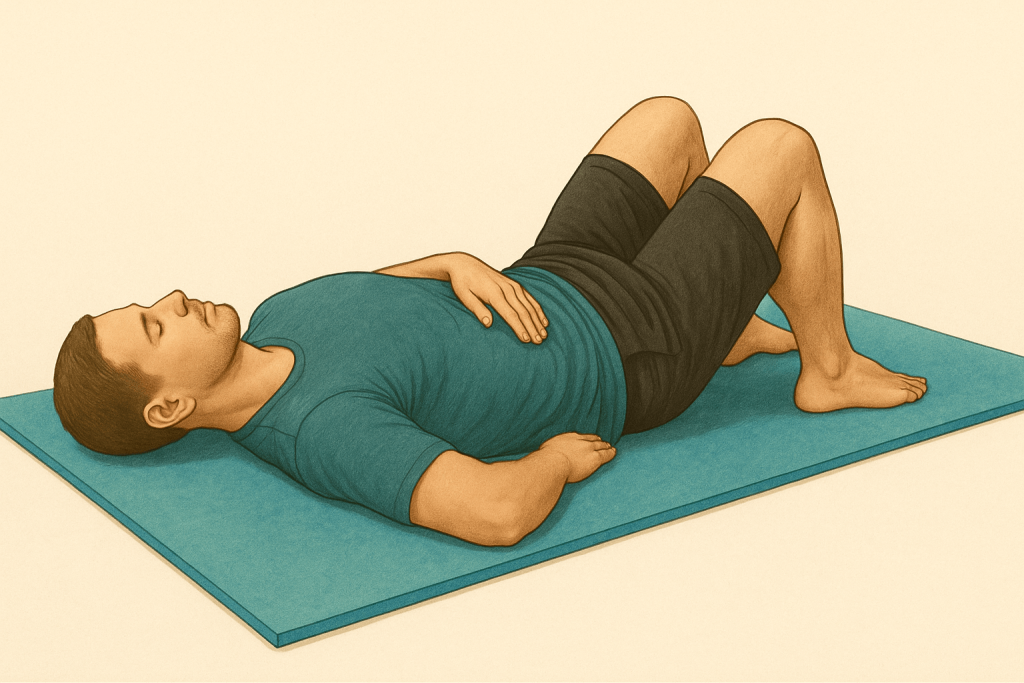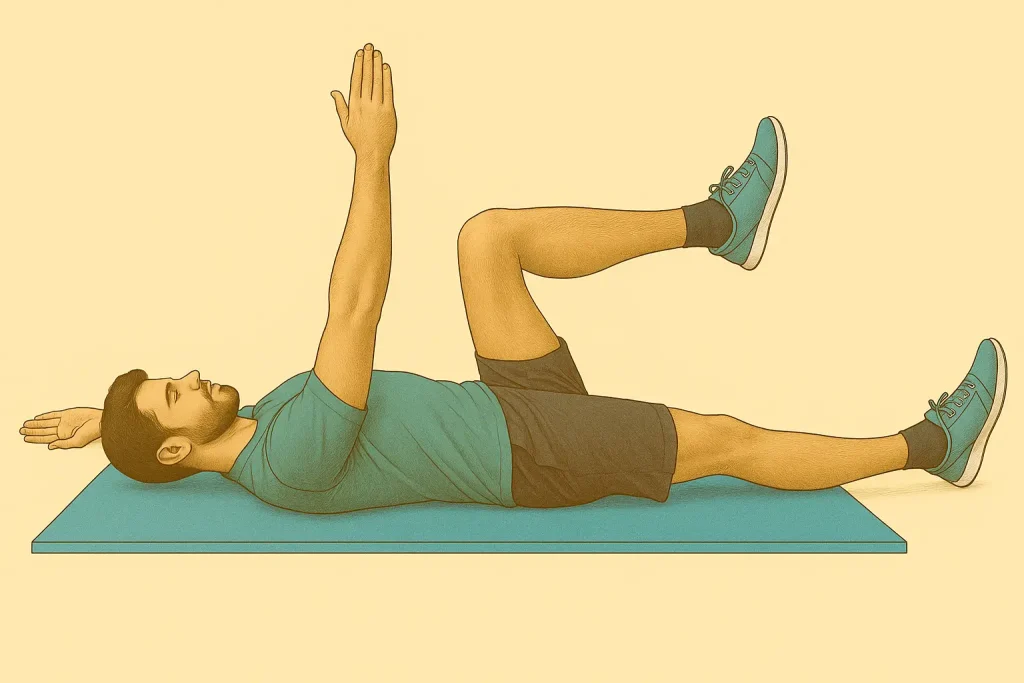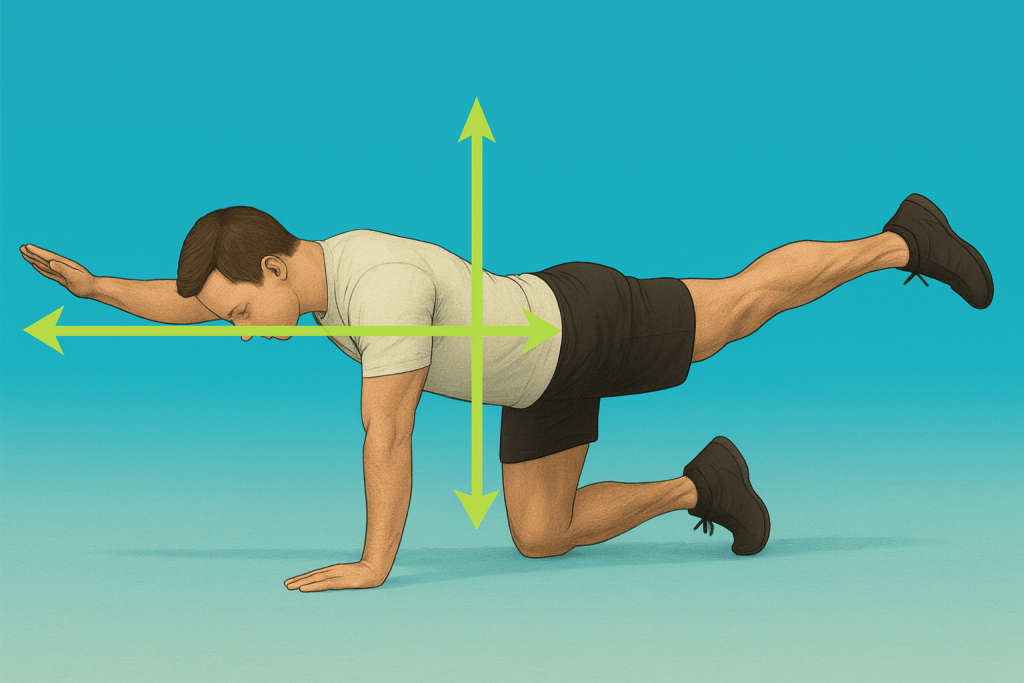If you’ve ever struggled with back pain, you know how much it can limit your life. Simple things like bending over, sitting at a desk, or even walking for too long can suddenly feel difficult or painful. While chiropractic care helps restore proper alignment and reduce stress on your spine, what you do outside the clinic is just as important.
One of the best things you can do to support recovery — and prevent future flare-ups — is to strengthen your core.
Jump to:
TLDR – Quick Guide
- Core strength is essential for spine support and back pain recovery
- Weak core = more strain on your spine
- Not all exercises are safe post-injury — avoid crunches or sit-ups
- Chiropractors recommend 4 safe, spine-friendly moves:
- Abdominal Bracing
- Pelvic Tilts
- Dead Bug
- Bird Dog
- Abdominal Bracing
- Do these 3–4 times a week for better posture, less pain, and stronger movement
- Pair exercises with ABC care for best results
Why the Core Matters
When most people hear “core,” they think of six-pack abs. But your core is much more than that. It includes:
- The deep abdominal muscles (transverse abdominis) that wrap around your midsection like a natural corset
- The obliques along your sides
- The spinal stabilizers in your lower back
- The pelvic floor and diaphragm, which also play a role in stability
Together, these muscles form a support system for your spine. If the core is weak, the spine has to carry more strain, which can lead to pain, stiffness, or even re-injury. A strong core works like an internal brace — protecting your back during daily activities.
But here’s the key: not all core exercises are safe after back pain. Sit-ups, crunches, and twisting movements can put unnecessary stress on healing tissues. The best exercises are gentle, controlled, and designed to build stability, not strain.
4 Core Exercises Chiropractors Recommend
Below are four of the safest and most effective core exercises for patients recovering from back pain. They’re simple, low-risk, and can usually be done at home without equipment. Always check with your chiropractor before starting new exercises, especially if you’re recovering from an injury.
1. Abdominal Bracing (or “Drawing In”)
This is the foundation for all other core work. It trains your deep abdominal muscles to switch on and protect the spine.

How to do it:
- Lie on your back with knees bent and feet flat on the floor.
- Your head and spine need to be neutral. This means that your face should be straight towards the ceiling. If needed, place a book or cushion behind your head to get to that position. i.e. make sure your head is neither tilted back nor forward.
- Place one hand on your lower stomach, just inside your hip bones.
- Take a slow breath in, then gently draw your belly button in toward your spine. Imagine zipping up a tight pair of pants.
- Hold for 5–10 seconds while breathing normally.
- Relax and repeat 8–10 times.
Why it helps:
This teaches your body how to activate the muscles that stabilize your spine before you move.
Pro tip:
Keep it gentle — don’t “suck in” hard or hold your breath.
2. Pelvic Tilts
Pelvic tilts are a gentle way to build mobility in the lower back while engaging the deep core.

How to do it:
- Lie on your back with knees bent, feet flat on the floor.
- Head and spine neutral as before.
- Brace your abdomen as you learned above.
- Flatten your lower back into the floor by gently tilting your pelvis backward. Imagine tucking your tailbone under.
- Hold for 3–5 seconds, then return to neutral.
- Repeat 10–12 times.
Why it helps:
Strengthens the abdominal muscles and increases awareness of spine position.
Pro tip:
The movement should be smooth and small — don’t force it.
3. The Dead Bug
This exercise may look funny, but it’s excellent for training spinal stability while moving your arms and legs.

How to do it:
- Lie on your back with arms pointing toward the ceiling and knees bent at 90 degrees (shins parallel to the floor).
- Head and spine neutral as before.
- Brace your core as if preparing for a gentle poke in the stomach (abdominal bracing).
- Slowly lower your right arm and left leg toward the floor while keeping your back flat.
- Return to the starting position, then switch sides.
- Perform 6–8 reps on each side.
Why it helps:
Challenges your core to keep the spine steady while your limbs move, just like in walking or lifting.
Pro tip:
Move slowly and avoid arching your back. Brace hard enough to keep your body absolutely stable (no twisting or tilting allowed).
If this is too difficult, try only moving your arms or legs to begin with.
4. The Bird Dog
This exercise strengthens both the abdominals and the small stabilisers along the spine.

How to do it:
- Start on all fours with your hands under your shoulders and knees under your hips.
- Brace your core and slowly extend your right arm forward and your left leg back.
- Hold for 5 seconds, then return to starting position.
- Switch to the opposite arm and leg.
- Perform 6–8 reps per side.
Why it helps:
Improves balance, coordination, and spinal control.
Pro tip:
Keep hips level — avoid twisting.
Putting It All Together
You don’t need to do hundreds of reps or spend hours exercising to strengthen your core. Quality matters more than quantity.

Here’s a simple starting routine:
- Abdominal Bracing: 8–10 reps
- Pelvic Tilts: 10–12 reps
- Dead Bug: 6–8 reps per side
- Bird Dog: 6–8 reps per side
Do this routine 3–4 times per week, or as recommended by your chiropractor. Over time, you’ll notice better posture, more stability, and less strain on your back during daily life.
Tips for Safe Core Training
- Listen to your body. Stop if you feel sharp pain.
- Focus on form. Slow, controlled movements are most effective.
- Breathe naturally. Don’t hold your breath.
- Stay consistent. Improvement comes with regular practice.
The Role of Chiropractic Care
While exercises are important,remember that core strength is just one part of recovery.
Advanced BioStructural Correction care helps by:
- Correcting spinal misalignments that increase strain
- Improving posture so your core can function better
- Relieving pain and stiffness so exercise feels safe
- Providing guidance tailored to your stage of recovery
Together, Advanced BioStructural Correction and safe core exercises create a powerful combination for healing and preventing future back pain.
Key Takeaways
Recovering from back pain can feel like a long journey, but strengthening your core is one of the best ways to protect your spine and reduce flare-ups. The exercises above — abdominal bracing, pelvic tilts, the dead bug, and the bird dog — are safe, simple, and effective starting points.
At Upright Posture, we help patients integrate these movements with personalized chiropractic care that corrects spinal alignment and speeds recovery. By combining targeted exercises with professional treatment, you give your body the best chance to heal fully, stay active, and live with less pain.
FAQs
1. How soon after back pain can I start core exercises?
You can often begin gentle core work like abdominal bracing within days of an injury — but only under professional guidance. Your chiropractor will help you determine the right timing based on your specific condition. Always start slow and avoid anything that increases pain.
2. Why are crunches and sit-ups not recommended?
These exercises put excess pressure on spinal discs and flex the spine in ways that may worsen back issues. During recovery, you want to stabilize and protect — not strain — your spine. Safer alternatives like dead bugs and bird dogs train your core without the risk.
3. How do I know if I’m doing these exercises correctly?
Proper form is critical, so move slowly and focus on control. Use mirrors, videos, or check-ins with your chiropractor or physiotherapist to ensure you’re activating the right muscles. Poor technique can lead to compensation and reduce the effectiveness of the workout.
4. Can I do these exercises if I have a disc injury or herniation?
Yes — but modifications may be needed. Chiropractors often adjust the range of motion or intensity to fit your condition. The key is choosing low-load, stable movements like these that don’t aggravate your spine.
5. How long before I see results from core exercises?
You may notice improvements in posture or pain levels within a few weeks. The real benefits — like reduced flare-ups and stronger daily function — usually appear after consistent practice over a couple of months. Pairing with chiropractic care can speed up your progress.






